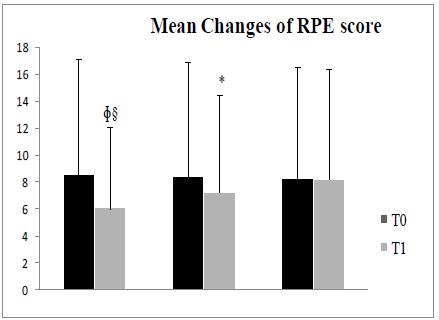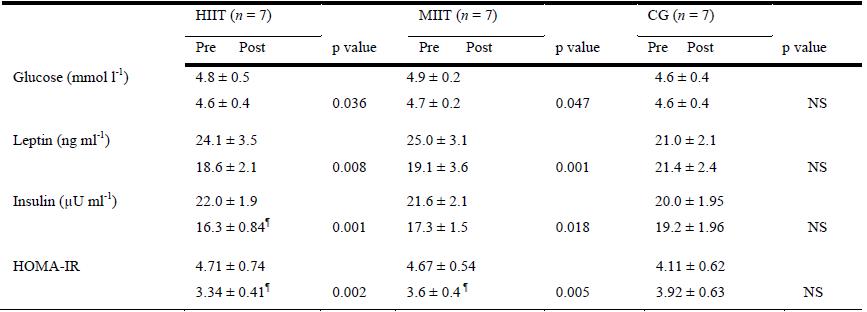Rating of Perceived Exertion and Serum Leptin Responses to Maximal Exercise in Obese Female Adolescents: Effects of Exercise Training Intensity
Abstract
Intensive exercise is one of the rarely used solutions to avoid obesity. This study aimed to examine the intensity effect [high-intensity interval training (HIIT) vs. moderate-intensity interval training (MIIT)] in severely obese female adolescents. Twenty one participants (age = 15.7 ± 0.9 years, percentage body fat (%BF) = 40.0 ± 1.5%) were assigned to HIIT: 100%; MIIT: 80% of Maximal Aerobic Speed (MAS) or control group (CG). Training program lasted 12 weeks, with sessions performed 3 times/week on the track. Running distances lasted 15 sec, interspaced with 15 sec active recovery. Body composition was assessed by Bioelectrical Impedance Analysis; blood pressure and rating of perceived exertion (RPE) were measured. Blood samples were collected at fast, and peak oxygen uptake (V̇ O2peak) was measured breath-by-breath using a calibrated portable telemetric system. All values were taken before starting and after the last training session in the intervention. Both exercise training programs enhanced positively; body composition (body mass, BMI-Z-score, %BF), cardiovascular fitness (blood pressures, resting heart rate, V̇ O2peak). Both exercise groups decreased plasma glucose (p< 0.05), insulin (p< 0.01 and p< 0.05; HIIT and MIIT) and leptin (p< 0.01). HIIT-group noted greater values in RPE score to maximal exercise (-29.0%, p< 0.001) compared to MIIT-group (-14.9%, p< 0.05). Overall, HIIT and MIIT induced beneficial changes in leptin sensitivity independently of exercise intensity. However, HIIT can be considered an efficient approach in decreasing the RPE score compared to MIIT, which may reduce the effort hardness and the drop-out from exercise in severely obese female adolescents.
Keywords: Enjoyment, post exercise, energy expenditure, satiety, obesity
Introduction
Previous studies on adolescents reported that interval training (IT) has proven to be the preferred
method compared to long constant intensity endurance training (Boutcher, 2011; Crisp et al., 2012).
The optimal exercise intensity prescription for achieving body fat loss and thereby decreasing leptin
level for the obese has not yet been identified. In addition, the effectiveness of a training program
depends on the level of participants’ adherence. Recent studies have shown that RPE method is useful
(Haddad et al., 2013, 2014). Therefore, the use of RPE method could help trainers to determine the
optimal intensity for exercise and to increase the participants’ motivation, which could help to avoid
the dropping out. The purpose of this study was to investigate whether high-intensity interval training
(HIIT) might be an effective intensity for obesity management in severely obese girls, by means of an
adaptation of leptin response and the perception of maximal effort as being of lesser hardness.
Materials and methods
Twenty one obese healthy adolescent females (age = 15.7 ± 0.9 years; Z-score of body mass index
(BMI-Z-sc) = 3.5 ± 0.5; percentage of body fat (%BF) = 40.0 ± 1.5) were assigned to HIIT (n = 7),
HIIT (n = 7) and control group (CG, n = 7). Duration-matched sessions were performed in both
training groups. The %BF was assessed using bioelectrical impedance analysis (TBF-300, Tanita®,
Tokyo, Japan), and resting blood pressures were measured. Rating of perceived exertion (RPE) method
(Foster et al., 2001) was used 30 minutes after the achievement of each testing session. Plasma glucose,
Results
In both groups, measurements elicited significant post intervention decreases in BMI (p< 0.05),
%BF (p< 0.01) and BMI-Z-score. WC was decreased only in HIIT group (ES = 0.49, p< 0.05). Systolic
and diastolic blood pressures also decreased in both groups. The RPE score decreased significantly by 29.0% and -14.4% in HIIT and MIIT groups, respectively (Fig. 1).

Significantly different within each group in comparison to the pre-test:p< 0.05
HIIT group decreased the glucose level (p< 0.05), leptin, insulin and HOMA-IR (p< 0.01), while
MIIT group significantly decreased glucose, insulin concentration (p< 0.05), leptin and HOMA-IR (p<
0.01), as shown in Table 1).

p value: significantly different within each group, before vs. after program HOMA-IR: homoeostasis model assessment index for insulin resistance Significantly different from control: p< 0.05
4. Discussions and conclusions
The findings of the present study attested that both training groups decreased their plasma leptin
levels significantly. Moreover, RPE score decreased for both training groups and this decrease was
significantly higher in HIIT than in MIIT group.
Importantly, peak oxygen uptake was enhanced in both groups due to training intensities which
could help obesity management. However, the significant decrease in %BF shown in both training
groups is congruent to the results shown in the study of Buchan et al. (2011). This decrease was based
more on the intensity and training duration, as evocated by Paoli et al., (2012). Such a decrease is
important at that age, since it was followed by a blood pressure decrease related to low insulin
resistance (Montani et al., 2002); this suggests a possible reduction of hypertension prevalence in obese
adolescents. Further, both training modalities enhanced positively the plasma leptin levels which were
based on supplementary energy expenditure leading to the body fat mass decrease. As recently
demonstrated (Alkahtani et al., 2013), the interval training intensity in the current study (HIIT and
MIIT) helped to decrease fasting plasma glucose levels in both groups. This is due to the enhancement
of insulin sensitivity (Host et al. 1998), shown in the following study by a decrease in HOMA-IR.
Further, the results of the present study demonstrate that obese participants prefer the short running
distances which are interspaced by recovery periods. Hence, both groups’ participants were able to
perceive maximal exercise intensity as less difficult compared to the beginning of the intervention.
This noted decrease encourages obese participants to adhere to exercise practice. In this context, we
have to note that HIIT group had the greater decrease in the RPE score, which corroborates with the
findings of a recent study (Alkahtani et al., 2013).
Therefore, we can conclude that the two types of training program reflected a decrease in plasma
leptin levels. Furthermore, both training models seem to be effective in triggering of leptin adjustments
and may be used as an efficient and safe strategy to prevent obese youth of being affected by type-2
diabetes and cardiovascular diseases. However, it may be helpful for young obese to practice HIIT, as
significant improvements in exercise enjoyment can occur. Particularly, HIIT might be a reasonable
approach to strengthen the enjoyment for the long term in severely obese adolescent females compared
to the MIIT.
Acknowledgements
The current study was supported by the Ministry of Higher Education, Scientific Research and
Technology of Tunisia.
References
Alkahtani, S. A., King, N. A., Hills, A. P., & Byrne, N. M. (2013). Effect of interval training intensity on fat oxidation, blood lactate and the rate of perceived exertion in obese men. Springerplus, 2:532.
doi: 10.1186/2193-1801-2-532.
Boutcher, S. H. (2011). High-intensity intermittent exercise and fat loss. Journal of Obesity, 32(4), 684-691. Buchan, D. S., Ollis, S., Young, J. D., Thomas, N. E., Cooper, S. M., … & Baker, J. S. (2011). The effects of time and intensity of exercise on novel and established markers of CVD in adolescent youth. American Journal of Human Biology, 23(4), 517-526.
Crisp, N. A., Fournier, P. A., Licari, M. K., Braham, R., & Guelfi, K. J. (2012). Adding sprints to continuous exercise at the intensity that maximises fat oxidation: Implications for acute energy balance and enjoyment. Metabolism, 61(9), 1280-1288.
Foster, C., Florhaug, J. A., Franklin, J., Gottschall, L., Hrovatin, L. A, … & Dodge, C. A. (2001). A new approach to monitoring exercise training. J Strength Cond Res., 15(1),109-115.
Haddad, M., Chaouachi, A., Castagna, C., Hue, O., Wong, D. P., … & Chamari, K. (2013). Validity and psychometric evaluation of the French version of RPE scale in young fit males when monitoring training loads. Sciences & Sport, 28(2), e29-e35.
Haddad, M., Chaouachi, A., Wong, D. P., Castagna, C., Hue, O., … & Chamari, K. (2014). Influence of exercise intensity and duration on perceived exertion in adolescent athletes. European Journal of Sport Science, 14(1), S275-281.
Host, H. H., Hansen, P. A., Nolte, L. A., Chen, M. M., & Holloszy, J.O. (1998). Rapid reversal of adaptive increases in muscle GLUT-4 and glucose transport capacity after training cessation. Journal of Applied Physiology, 84(3), 798-802.
Montani, J. P., Antic, V., Yang, Z., & Dulloo, A. (2002). Pathways from obesity to hypertension: From the perspective of a vicious triangle. International Journal of Obesity Related Metabolism Disorder, 26(2), S28-38.
Paoli, A., Moro, T., Marcolin, G., Neri, M., Bianco, A., … & Grimaldi, K. (2012). High-Intensity Interval Resistance Training (HIRT) influences resting energy expenditure and respiratory ratio in non-dieting individuals. Journal of Translational Medicine, 10:237. doi: 10.1186/1479-5876-10-237.
Copyright information

This work is licensed under a Creative Commons Attribution-NonCommercial-NoDerivatives 4.0 International License.
About this article
Publication Date
10 June 2016
Article Doi
eBook ISBN
978-1-80296-010-5
Publisher
Future Academy
Volume
11
Print ISBN (optional)
-
Edition Number
1st Edition
Pages
1-509
Subjects
Sports, sport science, physical education
Cite this article as:
Racil, G., Goebel, R. T., Haddad, M., Coquart, J., Chamari, K., & Amri, M. (2016). Rating of Perceived Exertion and Serum Leptin Responses to Maximal Exercise in Obese Female Adolescents: Effects of Exercise Training Intensity. In V. Grigore, M. Stanescu, & M. Paunescu (Eds.), Physical Education, Sport and Kinetotherapy - ICPESK 2015, vol 11. European Proceedings of Social and Behavioural Sciences (pp. 167-170). Future Academy. https://doi.org/10.15405/epsbs.2016.06.23

